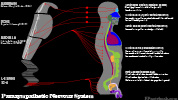II. Indications
-
Alzheimer's Disease
- Increased Cholinergic Activity by Anticholinesterases crossing the blood brain barrier may reduce Dementia related symptoms
- Central Cholinesterase Inhibitor examples include Aricept (Donepezil), Rivastigmine (Exelon), Galantamine (Reminyl)
-
Glaucoma
- Increased Cholinergic Activity the iris sphincter Muscle (Miosis)
- Pupil Constriction pulls the iris away from canal of schlemm, increasing Aqueous Humor outflow (decreases Intraocular Pressure)
-
Myasthenia Gravis
- Peripheral Anticholinesterases (e.g. neostigmine) prolong Acetylcholine activity at the Neuromuscular Junction
- Overcomes the myasthenia autoantibody binding of Neuromuscular JunctionNicotinic Receptors
III. Mechanism
-
Acetylcholine
-
Neurotransmitter for autonomic preganglionic Neuron Synapses (CNS to autonomic Ganglion)
- Acetylcholine mediates both preganglionic sympathetic and Parasympathetic Systems
-
Acetylcholine is Neurotransmitter for parasympathetic postganglionic Neurons (autonomic Ganglion to target organ)
- Acts at muscarinic and nictonic Acetylcholine receptors
-
Acetylcholine is the Neurotransmitter at the Neuromuscular Junction
- Muscle Contraction is triggered by release of Acetylcholine into the synaptic cleft
-
Neurotransmitter for autonomic preganglionic Neuron Synapses (CNS to autonomic Ganglion)
-
Acetylcholinesterase
- Acetylcholinesterase cleaves and deactivates Acetylcholine at the synaptic cleft, leading to a short AcetylcholineHalf-Life
- Cholinesterase Inhibitor (Anticholinesterase)
- Inhibit Acetylcholinesterase activity, thereby resulting in prolonged Acetylcholine activity within the Synapse
- Images
IV. Types
- Carbamyl Ester Inhibitors
- Inhibition of Acetylcholinesterase via competitively binding the Acetylcholine site
- On cleaving the Carbamyl Ester link, Acetylcholinesterase is carbamylated
- Acetylcholinesterase is deactivated for minutes to hours until it is reactivated by decarbamylation
- Examples include agents used in Dementia, Myasthenia Gravis and Glaucoma
- Organophosphorus Inhibitors (Organophosphates)
- High affinity binding to the Acetylcholine site renders Acetylcholinesterase permanently inactivated
- Acetylcholinesterase must be regenerated over days to weeks to Restore activity at the Synapse
- Examples include OrganophosphatePesticides and Nerve Agents
V. Medications: Central Nervous System Agents
- Central Cholinesterase Inhibitor for Dementia Management
-
Physostigmine
- Carbamyl Ester Inhibitor administered IM/IV for reversal of AnticholinergicOverdose
VI. Medications: Peripheral Nervous System Agents (Myasthenia Gravis)
- Neostigmine (Prostigmine)
- Pyridostigmine (Mestinon)
- Ambenonium (Mytelase)
- Prolonged activity
VII. Medications: Ocular Topical Agents (Glaucoma)
- See Intraocular Parasympathomimetic
- Demacarium (Humorsol)
- Echothiophate (Phosphate Iodide)
VIII. References
- Olson (2020) Clinical Pharm, Medmaster, Miami, p. 26-7


